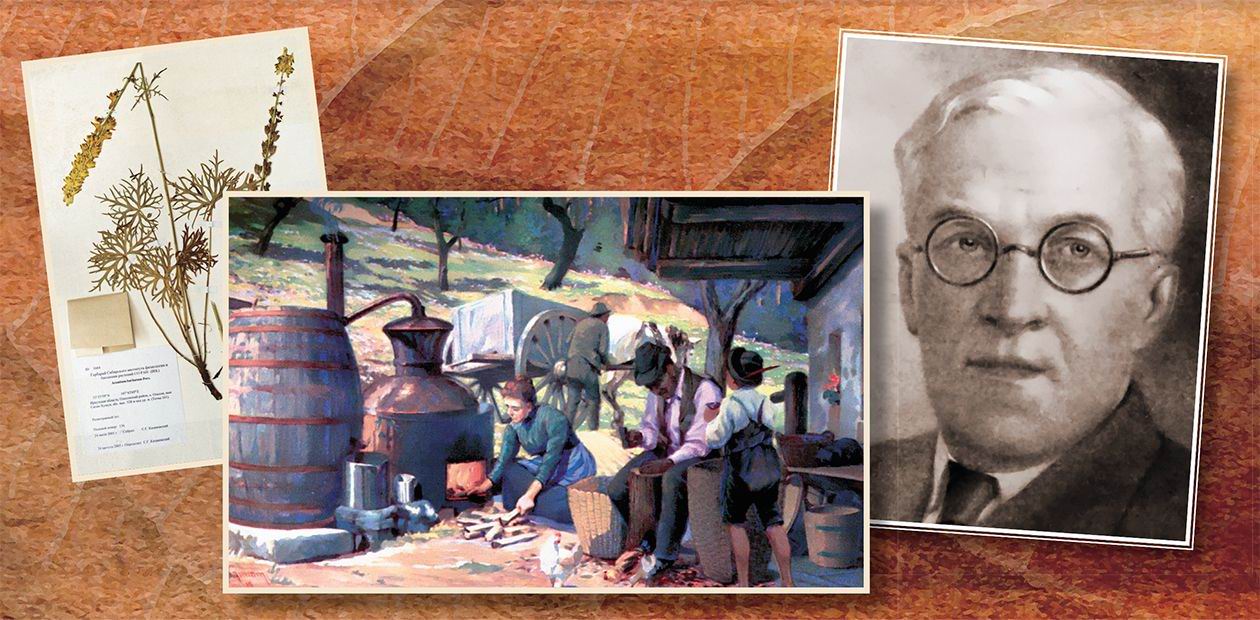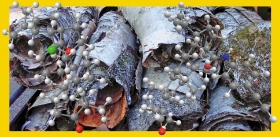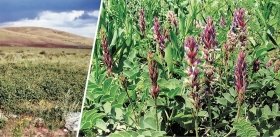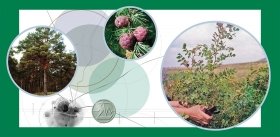Essays on Plants
We are offering our readers the first publication devoted to phytochemistry and phytopharmacology, which has been prepared based on the materials supplied to the Editors by a dynasty of well-known Russian scientists: RAS Academician G. A. Tolstikov (Vorozhtsov Institute of Organic Chemistry, RAS Siberian Branch), RAS Corresponding Member A. G. Tolstikov ( RAS Presidium, Moscow), and Doctor of Biology T. G. Tolstikova (Vorozhtsov Institute of Organic Chemistry, RAS Siberian Branch).
The article dwells on the history of herb treatment, traditional and modern techniques of making drugs from plants, and also on alkaloids — drastic plants that have enjoyed a bad reputation long since but that can turn into medicine in skilful hands.
In the journal’s issues to come, we are going to give floor to the authors themselves, who will introduce us to the boundless world of plants — our friends, helpers, and doctors — and to the traditional and up-to-date technologies for making drugs out of low-molecular plants
In the many centuries during which man has studied plants, the concept of phytochemistry, a branch of chemistry dealing with the structure and transformations of chemical compounds produced by plants, has developed. A close relation to phytochemistry, phytopharmacology, is concerned with the problems of biological activity of plants (or plant metabolites), thus making part of the medical science.
Organic substances which are constituents of the plants to be dealt with below can be arbitrarily divided into two classes of compounds: high-molecular and low-molecular. The first class is predominantly composed of monosaccharide polymers like glucose, xylose, and galactose. Typical representatives of polysaccharides are such glucose polymers as cellulose, the basic material from which plants are built, and starches, which can be labeled as energy accumulators.
We will mainly focus our attention, however, on low-molecular organic substances constituting the class of the so-called secondary metabolites. Their role in plants’ life, though not completely clarified, is of paramount importance. Today, they are known to be responsible for the plants’ growth and development; they protect their hosts against pathogenic microorganisms, fungi, and insect pests. Research into the functions of an amazing variety of metabolites promises a lot of sensations.
People’s interest in low-molecular organic substances roots in their need for food, medicine, raw materials for their industries, and other such things that determine the quality of life. In terms of the amounts in which low-molecular organic metabolites are produced and consumed, at the top of the list are saccharose (130 million tons per year) and vegetable oils, consumed in similar quantities. The next is D-glucose extracted from organic starch (5 million tons per year). D-glucose is used to make D-sorbite (650,000 tons), which is indispensable in ascorbic acid production. In the last decades, demand has emerged for such monosaccharides as D-fructose (60,000 tons), D-xylose (25,000 tons) and xylitol (30,000 tons), applied in medicine and food industry.
Low-molecular metabolites include various kinds of turpentine, crude turpentine, and rosin extracted from coniferous trees. Turpentine (annual output of 200,000 tons) has recently become important in chemical industry. For instance, over a quarter of this product is used to make scents, fragrances, and drugs for which there is an extensive market outlet. It is next to impossible to find a good replacement for rosins — these are used in the production of synthetic rubbers, rubber products like automobile tires, and high-quality paints and varnishes.
Also, new applications of resin acids obtained from the components of crude turpentine and rosins have sprung up. Research carried out in the last three decades has outlined the ways of turning them into the substances that in the future could be used as drugs. Production volume of low-molecular metabolites designed for such applications is much lower: from a few kilograms to a few dozens of tons.
History of healing with herbs
Pharmacognosy — study of plant metabolites based on folk wisdom and observations — dates back to the old days. Thirty-three out of 22,000 clay cuneiform plates excavated at the site of the palace of Assyrian king Ashurbanipal contain data on medicinal plants. Famous doctor Hippocrates described 236 medicinal plants. Greek physician and botanist Dioscorides, whose work Materia medica was regarded as the most competent medical guide until the 16th century, is recognized to be the “father of pharmacognosy”. Works by the ancient Greek physician Galen (his name is still attributed to infusions and decoctions made of plants) were highly appreciated as late as the 19th century.
The oldest Indian book on medicine Ayurveda (knowledge of life) contains information about 700 medicinal plants. On its basis the popular Tibetan book DjudShi (Essence of the Medicinal) was compiled. Up to these days, the herbal by the Chinese physician of the 16th century Li Shi-Chzhen describing 1,892 items is an indisputable source of information. Much consideration to medicinal plants was given in The Canon of Medicine, the widely popular multi-volume work by the great scientist Abu-Ali Ibn Sina (Avicenna).
The Slavs have practiced herb treatment long since. In ancient Russia, it was the job of soothsayers and quack-doctors, who passed on their skills orally from generation to generation. From them the torch was taken by monasteries, where storing up of medicinal herbs was organized. Regretfully, no written evidence has preserved on the situation with medicine in Russia before the mid-17th century.
In Russia health care became the concern of the state at the time of the tsar Aleksei Mikhailovich, who organized a special-purpose state body, Aptekarsky Prikaz, and especially during the reign of Peter I, who issued decrees on setting up drugstores and medicinal plant gardens.
Research into healing with medicinal plants was further promoted in 1778, when Russia’s first civil pharmacopoeia was published. The well-known public figure A. T. Bolotov put in the journal he published about 500 articles on medicinal plants. A great event of that time was publication of the multi-volume work on pharmacognosy by N. M. Maksimovich-Ambodik, which included descriptions of numerous medicinal plants.
In the first half of the 19th century, however, the “Peter’s urge” grew weaker. State supplies of troops with drugs introduced by the tsar were cancelled, medicinal plant gardens and Galen laboratories became history, and the system of storing up herbs fell apart. Numerous private drugstores focused on selling imported raw materials and drugs. Russian pharmacopoeia ceased to be published, and drugstores began using German pharmacopoeia.
Without denying the need to study the world scientific experience, we cannot fail to note that Russia’s authorities from time to time make the same mistakes. Regretfully, the syndrome of canceling centralized care about the nation’s health has survived to our days — over a century and a half later
Extraction of organic substances. From distillation to chromatography
The main techniques used to derive the necessary substances from plants are not many.
First comes extraction with the help of appropriate solvents: water, alcohol, acetone, ethers, etc. Extraction is applicable to large volumes of plants: tens and hundreds of thousands of raw materials are processed annually in the world with a view to obtaining the substances chemical industry requires.
Since the primary product of plant processing is normally complicated mixtures of substances, an important requirement to high technologies is the development of techniques that would allow isolating individual compounds. Such techniques currently used in mass production are adsorption and ion exchange chromatography, highly efficient liquid chromatography, membrane separation, thin rectification, and many other methods.
An old method that still works well is distilling with water vapor, which is used to isolate volatile compounds such as ether oils. For instance, mint oil valued for the menthol it contains is obtained through vapor distilling the tops of peppermint gathered during the blooming period. In this period sage, geranium, and lavender are also observed to have maximum concentrations of ether oils.
Jasmine, ylang-ylang and the especially precious rose oil are derived solely from flowers. A heap of rose petals prepared for vapor distillation is something fabulous, not easy to forget. A place of honor, in the eyes of perfumers, belongs to iris oil extracted from the plant’s roots. As for anise and coriander oils, they are derived from the seeds. By the early 1980s, over 35 kinds of ether oils were used in the production of drug additives, perfumery, and cosmetics products; undisputable champions among these in terms of volumes produced are citrus oils.
Vapor distillation of crude turpentine derived from coniferous trees and the so-called stump wood — the product of stump extraction — can yield tens of thousands of tons of turpentine. No smaller amount of turpentine is made in the process of turning wood into pulp. Crude turpentine (wood resin) is gathered from the trees — the oldest technique known since the pre-Biblical times. Resins were collected not only in the spots where the tree trunk or branch was accidentally damaged — their oozing was stimulated by making cuts on the tree trunks. In this way boxing was invented: the method that practically has not changed in the last few thousand years.
Resins from various trees were widely used in ancient medicine. For example, they are known to have served as a disinfecting coating applied to wounds. Incenses burnt in temples when sacrifice was offered were found to have a disinfecting effect too: this property of resins was noticed by ancient Egyptians during plague epidemics.
In the old times the art of making fragrances and ointments — cosmetic products that can be rightfully regarded as remedies — received primary emphasis. Thus, among the gifts the Queen of Sabba gave to King Solomon were resins and balsams from Southern Arabia. And the Persian King Darius enjoyed the services of forty expert cosmeticians during his campaign against Greece!
The myrrh praised by poets in their songs is also an aromatic resin that oozes from cuts in the bark of the Arabian tree Commiphora. Remember the story Sulamith by Kuprin: “The aromatic, old, fat, and wrinkled eunuch Egyptian carefully poured from a Phoenician phial to the tiny ceramic bottle as many drops of myrrh as there were solidi in all Sulamith’s money and, this done, said, wiping the oil trace around the phial’s neck with a sponge and laughing roguishly, ‘Dusky-faced girl, beautiful girl! When your darling kisses you tonight between your breasts and tells you, ‘How good your body smells, oh my beloved!” remember me. I poured you three extra drops”.
Finally, Egyptian priests used cedar resin and rosin, or colophony, for embalming. By the way, the word “colophony” derives from the name of the town of Colophon in Asia Minor, renowned for its way of thermal treatment of coniferous crude turpentine to make colophony and turpentine. There are good grounds to believe that this technique was borrowed from the masters of Ancient Mesopotamia. For a long time this art was considered to be lost, and revived thanks to the works of Arab alchemists in the 7th—8th cc. AD, after which it spread to medieval Europe.
So, we have obtained the target substances in this or that way. What does their future life look like? Despite a vast variety of technologies for organic metabolite processing, two approaches can be distinguished.
The first is to use the compounds in their native form. Notwithstanding its age, this approach has nor lost its importance up to now. For instance, as recently as in the 19th century they began using such drugs as quinine, extracted from the bark of cinchona to cure malaria; pain-killer morphine, derived from opium poppy; and regulator of the heart function strophanthin produced by the African plant strophantus. In the second half of the last century, they started to treat tumors with vinblastine and vincristine obtained from Convolvulus lineatus and camptothecin, the metabolite of the tree Camptotheca acuminate growing in the mountainous forests of South-Western China.
The second approach regards organic metabolites as the source material for guided chemical and microbiological transformations aimed at either enhancing the basic potency of the original substances or changing them to preparations with completely new properties.
The depth of structural transformations differs a lot. Frequently, no radical change in the structure is needed to improve drug transport in the organism and to boost the drug’s basic potency. Profound transformations of organic metabolites often require that the most up-to-date methods of high chemical technology be applied, which restricts their production volume.
To demonstrate how new drugs can be made from organic material, let us turn to the research done by national scientists which is connected with a most promising class of organic metabolites — alkaloids.
Alkaloid Odyssey
“This stuff for witches’ flights was prepared from poisonous lettuce, marsh celery, conium, nightshade, mandrake roots, soporific poppy, snail blood, and the fat of not baptized kids tortured by witches.” (from Resurrected Gods by D. Merezhkovky)
Poisonous plants that can intoxicate, induce the state of analgesia, or even kill a person have long since attracted the attention of people who practice healing, witchcraft, and sorcery.
Mandrake, mentioned in the quote above, was supposed to have magical power — the belief supported, to a large degree, by the humanlike shape of the plant. Root infusion could actually cause delirium, and medieval people thought that the devil himself spoke through the person who had taken the drink.
By the early 19th century, study of drastic plant remedies became an important line of investigation. In the first quarter of the century, scientists were especially interested in such remedies as opium, used to relieve pain; cinchona bark, imported to Europe by Jesuit fathers; and belladonna, applied to treat a number of diseases.
In 1806 the French pharmacist Serturner isolated morphine from opium and announced that he had discovered a new class of compounds — the so-called organic alkali. Twelve years later Meysner came up with the name of “alkaloids” (from the Latin alkali). In 1820 it was shown that the action of cinchona was caused by the alkaloid quinine, and in another eleven years atropine, the alkaloid from belladonna, was established responsible for the effect of dilating the pupil of the eye. From the present viewpoint, alkaloids are organic compounds isolated from plants and containing at least one atom of nitrogen.
The list of alkaloids known is extensive, the variety of their structures is enormous, and they all feature a high biological activity. (It should be noted that today to the list of organic alkaloids, produced by many thousands of plant species, we can add numerous substances synthesized by animals and sea organisms.)
Russian “Alkaloid Odyssey” began in 1928, when A. P. Orekhov returned to the USSR, having worked over 15 tears in laboratories of Switzerland and France. Great erudition and scientific achievements of this outstanding chemist helped him to set up, very quickly, a powerful school whose main line of inquiry was the study of alkaloid plants found in the country.
It should be remarked that at that time the flora of the Soviet Union, especially of its Asian part, was a true terra incognita for investigators. The most interesting findings in store for Orekhov and his colleagues were in Central Asia, whose flora happened to be exceptionally rich in plants producing alkaloids. Orekhov’s research school had a pronounced practical bent: works qualifying as theoretical research used to become industrial technologies in a matter of years. The main base of national alkaloid production became the Chemical Pharmaceutical Plant in Chimkent (Kazakhstan).
An exceptionally talented disciple of Orekhov was S. Yu. Yunusov. An Uzbek boy from a poor family, dressed in the national gown and famous Asian galoshes, he came to Moscow to study. Young Sabir turned out to be a hard nut to crack: having overcome all the barriers put in front of him by education officers, he managed to get the audience of Mikhail I. Kalinin, Chairman of the USSR Supreme Soviet.
Yunusov got what he wanted. Later, following the behests of his teacher, he set up in Uzbekistan a world-level scientific school, one of the largest and most prestigious. The Institute of Chemistry of Organic Substances, Uzbek Academy of Sciences, organized and headed by him investigated over a thousand alkaloids during the years of his directorship. The Institute’s expeditions worked in all regions of Central Asia and Kazakhstan, and after the school’s reputation was established, the Institute received samples of alkaloid plants from Siberia, Mongolia, and the Far East. The pilot plant of the institute not only produced large consignments of alkaloids necessary for pharmacological research and clinical tests but also developed regulations specifying the details of factory production of alkaloids. We can say with confidence that no research center in the world operated on such scale in the 1960s—1980s.
Among Yunusov’s gifted disciples is his son, M. S. Yunusov, now full member of the Russian Academy of Sciences, whose major interest is the so-called diterpenic alkaloids, the substances produced by delphiniums and aconites of the buttercup family. These beautiful plants are spread all over the territory of the former Soviet Union, especially in the mountainous regions of Central Asia, Kazakhstan, Altai, West Siberia, Trans-Baikal region, and Russian Far East. Star-shape fluorescing flowers of delphinium have such a deep blue color that when you come across them in the mountains, you think they must have been a source of inspiration of the outstanding artist Rerikh Sr.
Medicinal properties of delphiniums and aconites have been known in China and Tibet since the old days. Not all of the aconite species are harmless: for example, careless treatment of the roots and tops of the plants synthesizing the alkaloid aconitine may lead to poisoning and death.
The bad fame of these plants, however, did not scare off the scientists but rather instigated their interest. Among them was Yunusov Jr., who became involved in the development of cardioactive drugs on the basis of diterpenic alkaloids. It was established, in particular, that the most widely spread alkaloid lappaconitine, contained in a few aconites, has a strong anti-arrhythmic effect. As a result, in cooperation with the physicians from the Chazov school, allapinin was introduced in medical practice — it is used to treat various forms of heart arrhythmia.
In Russia, there is no problem with organic raw material for the production of this drug subject to proper organization of storing up plants. Thus, studies carried out by the botanists from the Ufa Research Center, RAS, have shown that in Bashkiria alone one can store up as many the roots of Aconitum septentrionale as it takes to make the minimum of 5 tons of the alkaloid annually, without doing any harm to the environment. This would be enough not only for the Russian health care system but also for export.
In the chemical shop of the Novosibirsk Institute of Organic Chemistry (NIOC), SB RAS, the first in Russia pilot production of lappaconitine on the basis of the Altai aconites has been set up. Scientists from the NIOC and Institute of Organic Chemistry of the Ufa Research Center, RAS, are currently developing, on the basis of this alkaloid, an anti-arrhythmic drug of a new generation.
The best anesthetic is … poison
Associated with alkaloid studies are many other memorable events of the chemistry of the last century, and some of those involved Soviet scientists. An example is investigation of curare — the poison that Spanish conquerors of South America discovered in the 16th century. Arrows with poisoned arrowheads were the weapon of the local population — the wounds inflicted with this weapon caused immobilization or even death. The Indians carefully hid the way of making it, but now it is known that curare is a complicated mixture of substances extracted from several poisonous plants. Bioactivity of different kinds of curare varies depending on the area in which it was made.
It was a great challenge to get an insight into the nature of curare’s unique toxicity. It was as late as in 1935 that the English chemist G. King succeeded in isolating, in its pure form, curare’s basic reactant tubocurarin. For a long time it was used in addition to anesthesia for muscle relaxation during abdominal operations.
Thorough research into the physiological action of tubocurarin has brought about the medical concept of curare-like drugs. A combination of anesthetics and these drugs was recognized to be one of the best methods for surgical anesthesia. The disadvantage was that this made production dependent on the insecure market of natural curare. As a result, two approaches to resolving this problem were taken: the first was synthesizing the necessary alkaloids and the second was searching for structural analogues with appropriate bioactivity.
Curare alkaloids were successfully synthesized thanks to the outstanding work done by scientists from the school headed by Prof. N. A. Preobrazhensky and his disciple, RAS Corresponding Member R. P. Evstigneeva. Active participants of the world race to synthesize combinations with curare-like effect were a team of chemists led by RAS Academician N. K. Kochetkov and Prof. A. P. Skoldinov. The outcome of the work done by our scientists was industrial production of original domestic drugs, which did not require many years or millions of dollars but just a state approach to the problem, very much like in the days of Peter I.
Phytopharmacology and the State
Problems directly or indirectly associated with the development of drugs on the basis of organic metabolites have been tackled by many leading organic chemists, pharmacists, and clinical experts of the world. They include some Nobel Prize winners: E. Fischer, R. Kun, L. Ruzhichka, and R. Robinson. The Russian “pantheon” also looks impressive: A. M. Butlerov, E. E. Vagner, the Arbuzovs (father and son), N. A. Preobrazhensky, and many others. In the second half of the last century, the impact on world research of investigators from Asia and South America — regions rich in wild flora and vast plantations of cultivated plants — became more pronounced.
Needless to say, development of clinically important drugs with multi-billion sales is a rather long, complicated, and expensive process. This is why medicines that have gained great clinical and commercial success do great credit to their developers.
As a rule, phytochemical investigations are the concern of the world’s largest international companies. In China, the state is also involved: it both introduces efficient national programs and signs mutually beneficial agreements with domestic businesses and large international concerns.
National programs launched in the USA also have a strong state support. An example is the National Cancer Institute (NCI), which has been running for several dozen years. Researchers from any country can send here any individual compounds or mixtures of substances and extracts of plants to be checked for cytostatic and anti-virus action.
In the former Soviet Union, the basis of phytopharmacy was the state approach to drug development introduced by Peter the Great. Consistent research in phytochemistry and phytopharmacology was carried out in the research institutes of the Far East and Siberian Branches of the Russian Academy of Sciences, the Academies of Sciences of Uzbekistan, Kazakhstan, Georgia, and Moldavia; of paramount importance for phytochemistry and phyto-industry were studies performed at institutes affiliated with specific sectors of economy. A great achievement of Soviet phytochemistry was exploration of the flora of the vast and not yet studied regions of Siberia, Russian Far East, Kazakhstan, and Central Asia.
The researchers made their best to multiply, and not to do any harm, to the country’s flora including wild and cultivated plants that were national property. In a short time, the country managed to set up an efficient system that made it possible to explore areas for medicinal plants, evaluate their resources, store up wild-growing plants, start farms specializing in growing valuable plants, and build phytopharmaceutical factories.
Regretfully, well-known developments of the latest time have ruined the efficiently running system. Resources of many wild-growing plants promising for phytochemical industry now belong to CIS countries; Russia has lost practically all of its phytochemical companies.
One might think that, in contrast to such geopolitical issues as the distribution of energy, ore, and timber resources, the development of organic resources for medical applications is of minor importance. In addition, the progress achieved in chemistry and technology has brought to life an enormous number of synthetic drugs based on petrochemical products. At present, about 200 drugs made from natural compounds and their semi-synthetic derivatives, developed at the laboratories of the world’s 50 pharmaceutical companies, are undergoing clinical tests. Forty-eight out of these drugs are of organic origin. Maybe interest in plant medicines is a matter of past and Russia should not cry over it? And yet, even a brief overview of the world’s situation in this area leaves no doubt that the phytochemical direction in medical chemistry and in drug industry is getting increasingly stronger.













